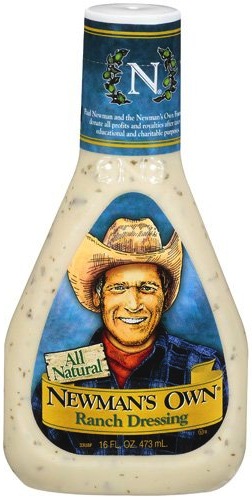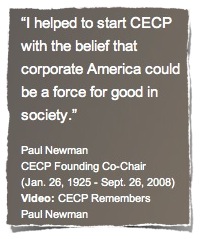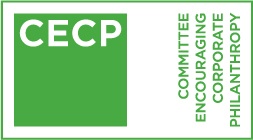 Summary. Philanthropic and socially engaged businesses and corporations seem to be competing with (and in some cases surpassing) non-profit organizations and government agencies in the race create a better world. This page offers examples of philanthropic businesses and organizations giving back to communities through charity. The question explored is whether these efforts are genuine or simply self promotion.
Summary. Philanthropic and socially engaged businesses and corporations seem to be competing with (and in some cases surpassing) non-profit organizations and government agencies in the race create a better world. This page offers examples of philanthropic businesses and organizations giving back to communities through charity. The question explored is whether these efforts are genuine or simply self promotion.
Rating Charitable Companies. Drug cartels also give back to their communities. What separates organized crime from legitimate businesses? It’s necessary to look at an entire company’s operation — labor practices, product quality, sourcing, and environmental impact — as well as the community impact of a company to determine the overall net-good they create in the world.
For-Profit, For Good. Social activists considering whether to start a non-profit sometimes choose to launch a business instead. Rather than pestering donors, they look for ways to turn a profit in the business world and let the excess revenue fully and perpetually fund the social causes they are passionate about.
 An example of this is the Newman’s Own brand of food products, founded by Paul Newman, that has raised over $300 million dollars for charity through the Newman’s Own Foundation.
An example of this is the Newman’s Own brand of food products, founded by Paul Newman, that has raised over $300 million dollars for charity through the Newman’s Own Foundation.
As one of the earliest examples of corporate philanthropy, Newman’s Own served as model for others to follow. Paul Newman later went on to help create the Committee Encouraging Corporate Philanthropy as a way to encourage others in corporate America to be “a force for good in society.”
Corporate partnerships with non-profits offers many of the benefits provided by endowment funds. Such partnerships mean that non-profits can focus on their work and spend less time (and money) on fundraising.
 Rather than simply giving money to charity, businesses are becoming more engaged in the work of charitable organizations. An example of this is TOMS — the shoe company that gives one pair of shoes to charity for every pair of shoes sold. It’s what they call their One-For-One campaign. By engaging more actively in the supply chain and delivery process, they are able to oversee the charitable work and ensure its effectiveness. Tom’s recently launched an eyewear line with the promise to give prescription eye glasses, or medical/surgical treatment, to one person for every pair of glasses purchased. Their One-For-One charitable vision wellness program is another example of a perpetually funded enterprise that’s almost indistinguishable from non-profit organizations engaged in the same work. To accomplish their goals, TOMS has partnered with Seva.org of Berkeley, California.
Rather than simply giving money to charity, businesses are becoming more engaged in the work of charitable organizations. An example of this is TOMS — the shoe company that gives one pair of shoes to charity for every pair of shoes sold. It’s what they call their One-For-One campaign. By engaging more actively in the supply chain and delivery process, they are able to oversee the charitable work and ensure its effectiveness. Tom’s recently launched an eyewear line with the promise to give prescription eye glasses, or medical/surgical treatment, to one person for every pair of glasses purchased. Their One-For-One charitable vision wellness program is another example of a perpetually funded enterprise that’s almost indistinguishable from non-profit organizations engaged in the same work. To accomplish their goals, TOMS has partnered with Seva.org of Berkeley, California.
 The Starbucks Foundation has developed Ethos Water brand bottled water that states on the label, “For every bottle of Ethos water you buy, Starbucks will donate 5 cents to support humanitarian programs in coffee-growing communities, providing clean, safe water to those in need.”
The Starbucks Foundation has developed Ethos Water brand bottled water that states on the label, “For every bottle of Ethos water you buy, Starbucks will donate 5 cents to support humanitarian programs in coffee-growing communities, providing clean, safe water to those in need.”
 GiveSomethingBack.com is an online office supplies vendor that’s been “named one of the most generous companies in America.” Their community giving page declares that they give “75 times more than other companies.” For every case of paper sold, seven meals are provided through local food banks.
GiveSomethingBack.com is an online office supplies vendor that’s been “named one of the most generous companies in America.” Their community giving page declares that they give “75 times more than other companies.” For every case of paper sold, seven meals are provided through local food banks.
Other companies have followed the above examples, including: CharityWater.org, GlobalGirlfriend.com, GoodSearch.com, GreaterGood.com (creators of TheHungerSite.com), and more.
 Do a Google search on Triple Bottom Line and in the top 10 results (out of over 3 million) you’ll find Better World Books — a kind of poster-child for the movement toward ethical, environmental, and socially engaged business practices seeking to improve the world. Their statement on a commitment to the Triple Bottom Line concludes with this proclamation: “…while most businesses answer only to their shareholders, we answer equally to all of our key stakeholders: our employees, our customers, our literacy partners, our investors and the environment.” Better World Books has partnered with non-profit literacy organizations and established itself as a perpetual donor.
Do a Google search on Triple Bottom Line and in the top 10 results (out of over 3 million) you’ll find Better World Books — a kind of poster-child for the movement toward ethical, environmental, and socially engaged business practices seeking to improve the world. Their statement on a commitment to the Triple Bottom Line concludes with this proclamation: “…while most businesses answer only to their shareholders, we answer equally to all of our key stakeholders: our employees, our customers, our literacy partners, our investors and the environment.” Better World Books has partnered with non-profit literacy organizations and established itself as a perpetual donor.
Criticism. Some people have expressed concern about the hybrid marketing of charity and corporate branding, citing that it creates confusion among consumers. In the case of Better World Books, some complaints have surfaced:
- “I’m not happy about being required to dropship for an outfit that masquerades as a non-profit, when it is anything but.” ~ Alibris dealer [source]
- “I too question the wisdom of signing on with a competitor who is nothing but a mega-listing penny seller. I would much rather contribute to the demise of such outfits rather than benefitting them by cooperation.” ~ Alibris dealer [source]
- “Our local state university used to host bimonthly book sales, open to students and the public. These were discontinued 2 years ago because some genius at the university, duped by their deceptive charitable status, decided to form a relationship with BWB. So a good supply of books was severed, and now BWB has the nerve to come poaching my inventory. They’re a destructive megalister, with poor descriptions, devaluing books by the thousands. Rumor has it they pay 50 cents per book.” ~ Alibris dealer [source]
- “You guys are the biggest scam artists that I’ve ever seen… You should also try putting some money into your crappy customer service department. And by the way, you’re lying about your ‘commitment’ to literacy programs. You have people donate on the false pretext that the books are going to be shipped over to needy kids in Africa but you really just sell them and give a SMALL percentage of the profit to the actual programs. Shame on you for lying and using these children for your false advertising and your greedy money hungry desires.” ~ disgruntled customer [source]
In response to the above criticism and others like it, John at Better World Books had this to say:
Theresa – we are certainly not perfect, and a small percentage of our customers do experience a customer service glitch. If this happened to you, please accept our apologies. You may contact me directly for resolution of your problem at john at betterworldbooks dot com. For perspective though, we do have a 97% positive seller rating on Amazon from 585,000 reviews (the most of any seller on Amazon) and a 99.6% positive rating on Half.com from 285,000 reviews.
We claim that we convert books donated into cash which then goes to our non-profit literacy partners. If you can point me to where you see an alternative claim, I would like to correct it. It is a side benefit that we have actually directly sent 1.3 million college textbooks to Africa, but this is not our primary business.
We do provide about 10% of our revenues to our non-profit literacy partners. For context, consider Target Corp., a best-in-class C Corporation when it comes to charitable giving. It donates 5% of its pre-tax profit to charity. In order to meet the bar we set of donating 10% of revenues, Target would have to donate 196% of its pre-tax profit to charity. We pay our literacy partners regardless of whether we are profitable and before we take any profit. We aim to maintain high single-digit social profit and to achieve high single-digit shareholder profit.
This response addresses some of the misconceptions about their charity work, and helps sets the record straight with regard to customer satisfaction, some concerns remain.
Locally owned independent bookstores are negatively impacted when they have to compete with Better World Books on pricing because, unlike BWB, local bookstores don’t get their books for free. This is an example of where even a company that is presumably well-meaning can have a devastating impact on small businesses, despite some of the other good they may be doing in the world. Similar concerns could exist about GiveSomethingBack.com office supplies. Do inexpensive online options for office supplies make it hard for small local stores to compete?
 As stated earlier, the Committee Encouraging Corporate Philanthropy (CECP) was originally established by Paul Newman as a way to encourage others in corporate America to be “a force for good in society.”
As stated earlier, the Committee Encouraging Corporate Philanthropy (CECP) was originally established by Paul Newman as a way to encourage others in corporate America to be “a force for good in society.”
Today membership in the CECP includes Alcoa, Archer Daniels Midland Company (ADM), Chevron Corporation, ConAgra Foods, ConocoPhillips, Deutsche Bank, Dow Chemical Company, DuPont, Exxon Mobil, General Electric Company, Goldman Sachs, Hearst Corporation, JPMorgan Chase, Merck, Pfizer, and Walmart.
The list of charitable businesses has grown to the point that just about every one of the top fortune 500 companies has some kind of “give back” campaign in place as if to say, “We’re giving, too!” So, how can a person distinguish one company from another.
“Corporate philanthropy has become part of a good strategic business plan. It is integral to corporate reputation, employee morale, and stakeholders at all levels.” ~ Ken Derr, Retired Chairman and CEO of Chevron Corporation [Source: CECP Website Home Page]
If corporate philanthropy is considered simply “part of a good strategic business plan” then how meaningful is it?
If charitable giving is simply factored into the bottom line, perhaps by inflating prices, then how meaningful is it?
 The Community Giving page of Walmart’s website has this statement: “At Walmart, we believe in a philosophy of operating globally and giving back locally. We know we can make the greatest impact on our communities by supporting causes that are important to our customers right in their own neighborhoods. We’re proud to be a ‘store of the community’ for all of the communities we serve by helping to provide financial and volunteer support to more than 100,000 charitable and community-focused organizations, and by using our locations to provide opportunities for our customers and associates to give back.” Walmart has given $2 billion toward hunger relief in America. Because Walmart is consistently cited as a primary cause for many small, locally run, locally owned, and locally supplied stores going out of business, their efforts to give to local communities are seen by some as a token gesture.
The Community Giving page of Walmart’s website has this statement: “At Walmart, we believe in a philosophy of operating globally and giving back locally. We know we can make the greatest impact on our communities by supporting causes that are important to our customers right in their own neighborhoods. We’re proud to be a ‘store of the community’ for all of the communities we serve by helping to provide financial and volunteer support to more than 100,000 charitable and community-focused organizations, and by using our locations to provide opportunities for our customers and associates to give back.” Walmart has given $2 billion toward hunger relief in America. Because Walmart is consistently cited as a primary cause for many small, locally run, locally owned, and locally supplied stores going out of business, their efforts to give to local communities are seen by some as a token gesture.
 You may not realize it, but BP is all about supporting communities and preserving the environment. At least that’s why they state on their working responsibly:
You may not realize it, but BP is all about supporting communities and preserving the environment. At least that’s why they state on their working responsibly:
“Supporting communities, preserving the environment. In other words, we have a long-term commitment to the communities we work within. As such, we recognise a responsibility to create more than quick revenues from our investments. Whatever we do, wherever we do it, we always strive to preserve and improve the surrounding environment, support enterprising business people and encourage energy-related education. This is why, for example, we planned the construction schedule for the BTC pipeline around the breeding season of a rare local grouse. And why we funded satellite transmitters to help experts track endangered sea turtles in the nearby seas. It’s why we’ve started programmes to share our business knowledge with entrepreneurs in Angola, South Africa, Trinidad and Tobago and elsewhere. It’s why we sponsor university programmes and send our employees into schools around the world, to help children learn how energy works and to inspire tomorrow’s energy experts. … We try to work in ways that will benefit the communities and habitats where we do business – and earn the world’s respect.”
The video below is a 10-minute digest from the movie On Deadly Ground about an oil company that creates a positive PR media campaign after a deadly oil spill and disaster. This is an example of how greenwashing is being used today by companies that are harming the environment.
 It’s well documented that terrorist organizations and drug cartels are committed community partners in giving toward schools, clinics, and other charitable causes. This builds local support and helps shape their public image. For example, “Hamas’ political wing provides welfare and social services to the … poor. The organization also builds schools and hospitals, and it develops social and religious projects.” [source] The Medellín drug cartel is credited with having “built schools, … roads, bridges, and health clinics.” [source]
It’s well documented that terrorist organizations and drug cartels are committed community partners in giving toward schools, clinics, and other charitable causes. This builds local support and helps shape their public image. For example, “Hamas’ political wing provides welfare and social services to the … poor. The organization also builds schools and hospitals, and it develops social and religious projects.” [source] The Medellín drug cartel is credited with having “built schools, … roads, bridges, and health clinics.” [source]
WHY COMPANIES GIVE BACK
To evaluate the net-good done by an organization or corporation, one needs to look at the big picture that includes labor practices, product quality, sourcing, environmental impact, and local community impact. It also helps to consider the various reasons why a company is engaged in philanthropy. Here’s a short list:
- Passion. For some companies, the business-side of their operations are simply a front-organization to fund their passion for creating a better world.
- Expectations. Some businesses give because consumers expect it.
- Incident Remediation. Companies are sometimes compelled to engage in positive PR campaigns to help offset negative stories in the media (like BP after the spill).
- Protective Coloration. In the animal world, protective coloration is what allows animals to blend in with their surroundings and avoid predators. In politics, sometimes a politician will associate with people to influence voter perceptions. For example, a politician who has a poor labor record will try to get photos taken with those recognized as being strong advocates for workers rights. In today’s increasingly environmentally aware society, companies with a poor environmental record will create a pro-environment campaign to cover that up.
- Offset. Some companies are engaged in ongoing activities that are harmful to society or the environment (or at least they perceived that way by many). Walmart is consistently cited as the primary cause for many small, locally run, locally owned, and locally supplied stores going out of business. So, Walmart makes an effort to promote awareness about their community giving stating, “We’re proud to be a ‘store of the community.'” Altria (previously Phillip Morris) is considered to be perpetuating the use of tobacco and contributing to cancer. So, their socially responsible campaigns help dilute the negative perceptions that some people have.
- Build Local Support. Drug cartels and terrorist organizations are exceptionally charitable within their own communities and are known to build schools, clinics, and give to charitable organizations. This helps build local support and create a positive awareness and perception about their brand. Some businesses give the the local community for similar reasons.
Final Thoughts…
“When I first started out in business, corporate philanthropy meant presenting an oversized check and going home. For the most part, those days are over. From what I have seen at Western Union and heard from my peers at events such as those held by CECP, there is a growing emphasis on multilayered partnerships across sectors. Nonprofits would do well to consider the full range of benefits they can offer their corporate sponsors and present innovative ways to deliver value to the stakeholders companies most want to reach.” ~ Christina Gold, chief executive officer of Western Union, from the article Rethinking Corporate Giving: Western Union’s CEO Offers Her Philosophy
“One problem with the triple bottom line is that the three separate accounts cannot easily be added up. It is difficult to measure the planet and people accounts in the same terms as profits—that is, in terms of cash. The full cost of an oil-tanker spillage, for example, is probably immeasurable in monetary terms, as is the cost of displacing whole communities to clear forests, or the cost of depriving children of their freedom to learn in order to make them work at a young age.” ~ The Economist, 7 November 2009